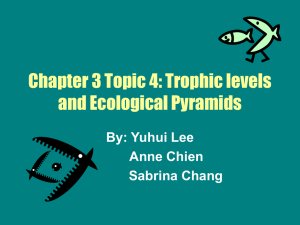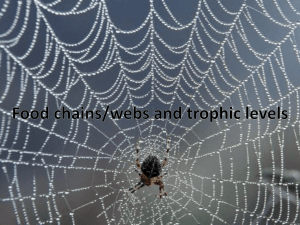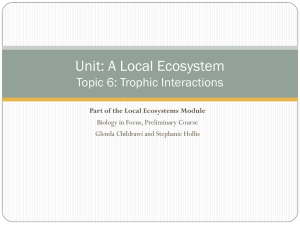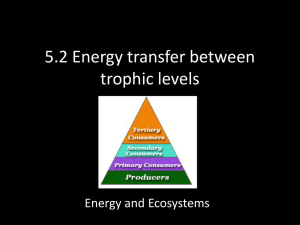2.2 Notes
advertisement
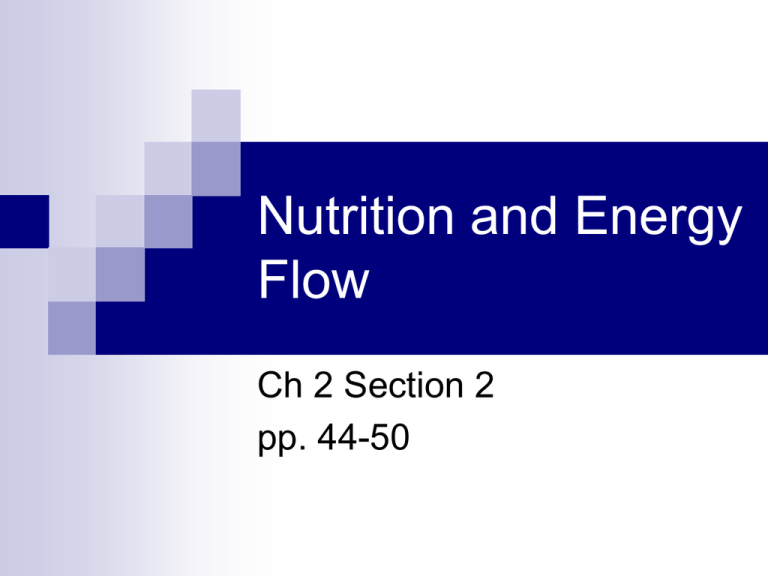
Nutrition and Energy Flow Ch 2 Section 2 pp. 44-50 Energy All life needs energy to survive One of the most important characteristics of a species’ niche is how it obtains energy. Ultimate source of energy comes from the __________! Plants use the sun’s energy to manufacture food in a process called _______________. Producers or AUTOTROPHS An organism that uses light energy or other forms of energy to make energy-rich compounds (or their own food) is a producer, or autotroph. Heterotrophs Consume Producers and Other Consumers Other organisms in the biosphere depend on autotrophs for nutrients and energy. These dependent organisms are called consumers OR HETEROTROPHS. Consumers cannot use the sun’s energy directly like producers CONSUMERS MUST CONSUME OR EAT PRODUCERS OR OTHER CONSUMERS Types of consumers Herbivore Carnivore Omnivore Scavengers and Decomposers Heterotrophs: Scavengers Scavengers eat animals that have already died. Heterotrophs: Decomposers Some organisms, such as bacteria and fungi, are decomposers. Decomposers break down dead and decaying plants and animals into simpler molecules that can be more easily used by other organisms. THEY RECYCLE MATERIALS! Food chains: Pathways for matter and energy A food chain is a simple model that scientists use to show how matter and energy move through an ecosystem. In a food chain, nutrients and energy (food) move from autotrophs to heterotrophs and, eventually, to decomposers. USE DIAGRAM ON NEXT PAGE TO CONSTRUCT A FOOD CHAIN The amount of energy remaining in the final transfer is only a portion of what was available at the first transfer. A portion of the energy is given off as heat at each transfer. Trophic Levels and Food Chains Each organism in a food chain represents a feeding step, or trophic level, in the passage of energy and materials. TROPHIC LEVELS ARE LIKE LINKS IN A FEEDING CHAIN! A first order heterotroph (PRIMARY CONSUMER) is an organism that feeds on plants, such as a grasshopper. A second order heterotroph (SECONDARY CONSUMER) is an organism that feeds on a first order heterotroph. A third order heterotroph (TERTIARY CONSUMER) feeds on second order heterotrophs Simple Food Chains A food chain is drawn using arrows to indicate the direction in which energy is transferred from one organism to the next. HOW MANY TROPHIC LEVELS OR FEEDING STEPS ARE THERE? berries → mice → black bear Food Webs A food chain represents only one possible route for the transfer of matter and energy through an ecosystem. A food web, shows all the possible feeding relationships at each trophic level in a community. Chihuahuan raven Food webs Honey mesquite (pods eaten by beetles) Pronghorn antelope Gambel quail Jackrabbit Long-tail weasel Desert tortoise Prickly pear cactus Coyote (top carnivore) Roadrunner Kangaroo rat (seed eater) ants Texas horned lizard Red spotted toad Mexican whiptail lizard Mojave rattlesnake Energy and trophic levels: Ecological pyramids An ecological pyramid can show how energy flows through an ecosystem. The base of the ecological pyramid represents the autotrophs, or first trophic level. Higher trophic levels are layered on top of one another. Energy and trophic levels: Ecological Pyramid of Energy pyramids The pyramid of energy illustrates that the amount of available energy decreases at each succeeding trophic level. Heat Heat 0.1% Consumers 1% Consumers 10% Consumers Heat Heat 100% Producers Energy and trophic levels: Ecological pyramids The total energy transfer from one trophic level to the next is only about ten percent because organisms fail to capture and eat all the food energy available at the trophic level below them. Energy and trophic levels: Ecological pyramids Some of the energy transferred at each successive trophic level enters the environment as heat, but the total amount of energy remains the same. Energy and trophic levels: Ecological pyramids Pyramid of Numbers Fox (1) Birds (25) Grasshoppers (250) Grasses (3000) A pyramid of numbers shows that population sizes decrease at each higher trophic level. Energy and trophic levels: Ecological pyramids Biomass is the total weight of living matter at each trophic level. A pyramid of biomass represents the total weight of living material available at each trophic level. Pyramid of Biomass 1 kilogram of human tissue 10 kilograms of beef 100 kilograms of grain To return to the chapter summary click escape or close this document. To return to the chapter summary click escape or close this document. The Nitrogen Cycle To return to the chapter summary click escape or close this document. The Carbon Cycle To return to the chapter summary click escape or close this document. The Water Cycle To return to the chapter summary click escape or close this document.

